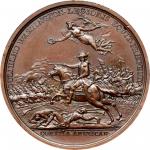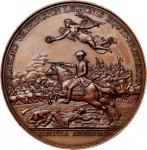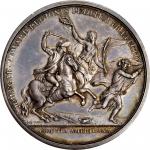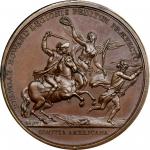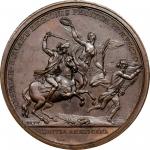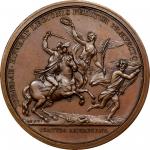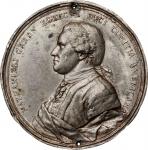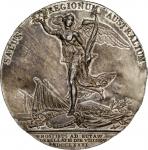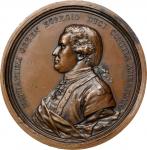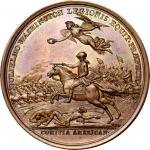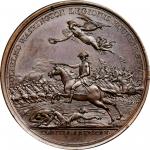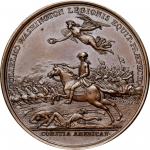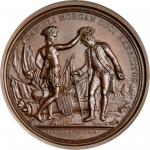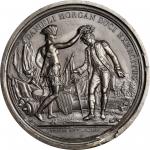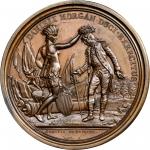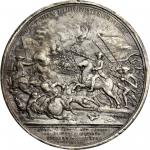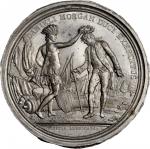1781 (ca. 1863-85) William Washington at Cowpens medal. Betts-594, Julian MI-8. Copper. Copper. Bell-metal (i.e. “gunmetal”) transfer dies. Philadelphia Mint. 45.2 mm, 729.0 grains. 4.6 - 4.7 mm thick. Mint State.Plain squared edge. A particularly interesting piece, one that so closely resembles an early Paris Mint striking on its face that it would easily mislead most experts. The die state is advanced, leaving the long die scratch from T of WASHINGTON to the wing of the flying Fame is no longer visible. The prominent lapping or filing lines in the obverse exergue are likewise gone, but the tell-tale spikes from the inside rim below the A of COMITIA and the first A of AMERICANA remain. The light mahogany color and satiny luster is clearly a U.S. Mint bronzed patina upon inspection, but it is not far removed from the reflective light coppery surface of Paris Mint productions. The planchet thickness (thicker than Paris pieces) and diameter (narrower that Paris pieces) are giveaways here. A raised wire rim surrounds most of the reverse of this piece, with no evidence of filing to truncate it. The surfaces are free of major problems, though we note some darker toning splotches in the reverse wreath at 11:00 and 6:00. A fascinating piece for specialists, and a very attractive example of this Philadelphia Mint issue.<p><strong>The Philadelphia Mint Comitia Americana Medals from Bell Metal Dies</strong><p><p>Even though coin collecting did not fully blossom into a national hobby until the end of the 1850s, medal collecting had a dedicated following even from the era of the Revolution. Pioneering specialized works on early American medals by Dr. James Mease (1821), J. Francis Fisher (1837), Thomas Wyatt (1848), all preceded Benson J. Lossings popular history <em>A Pictorial Field-Book of the Revolution,</em> which was published serially beginning in 1850 and on its own in 1853. Lossings work introduced many Americans to the Comitia Americana series within their historical context, offering accurate illustrations to would-be collectors who may never have known such things existed otherwise.<p><p>The U.S. Mint began producing medals for sale to a collector clientele by the early 1840s. By 1841, Chief Coiner Franklin Peale had inventoried the medal dies on hand at the Philadelphia Mint, and soon thereafter he began making electrotypes to satisfy collector demand. The August 3, 1844, issue of the Niles Weekly Register, a nationally distributed newspaper, ran the list of medal dies Peale had on hand, which included only Horatio Gates (added to the Mint collection in 1801) and Daniel Morgan (acquired from Paris in 1840) from the Comitia Americana series. But the Mint also offered electrotypes of Washington Before Boston, Anthony Wayne, De Fleury, William Washington, John Eager Howard, Nathanael Greene, and John Paul Jones. The Lee obverse was discovered at some point in the next decade or so, as Mint Director Snowden included it on a list of dies held by the Mint that was published in the Report of the Director of the Mint in 1854. He noted that the reverse was "(Not in the mint)."<p><p>When the large cent series ended in 1857, provoking nostalgia and a newfound interest in saving old coins, an upswell in collector-oriented literature spread word of the world of numismatics all over the country. Local newspapers ran columns and widely-read magazines like Harpers included numismatic content. In 1860, Mint Director James Ross Snowden published a book on the contents of the Mints coin cabinet, then followed that effort a year later with his <em>A Description of the Medals of Washington, of National and Miscellaneous Medals, and of Other Objects of Interest in the Museum of the Mint.</em> Snowdens book offered accurate images of the medals to the Mints growing retail clientele, which seemed to create exactly the byproduct Snowden wished, demand for the Mints most profitable product line: medals.<p><p>It is perhaps no coincidence than the Mint sought to capitalize upon this demand as best they could. The late 1850s and early 1860s saw many new medals added to the Mints list, including several new Washington-related medals (Snowdens pet interest). Cognizant that the U.S. Mint should be able to sell the medals authorized by the Continental Congress, at some point in 1861, James Pollock, the former governor of Pennsylvania who had taken over as Mint Director, wrote to the Paris Mint to request the French government forward the original dies to all American medals they held. The French, understandably, declined, but the Paris Mint was kind enough to sell the anxious Americans 20 specimens each of four medals: the Washington Before Boston, William Washington, John Eager Howard, and John Paul Jones. These medals arrived in Philadelphia in March 1862.<p><p>While a fixed supply was undoubtedly nice to have, Pollock wanted to control the means to produce these medals for the growing legions of new customers. He thus ordered the engraving department to produce new dies, hubbed from the medals newly arrived from Paris. A medal made of relatively soft copper would not work as a hub for a die made of steel, thus a composition softer than copper would need to be used to make the dies.<p><p>These dies have been called the "gunmetal" dies for more than a century, though as numismatist (and metallurgist) Craig Sholley wrote in the August 2018 issue of <em>The Numismatist,</em> the term is a misnomer. Sholley traced the first use of the term "gunmetal" to William Spohn Bakers 1885 <em>Medallic Portrait of Washington</em>. Baker described the first Washington Before Boston medals struck at the Philadelphia Mint and offered this story on their origin:<p><p>This medal furnished at the United States Mint, is struck from gun metal dies made in 1860 from a medal with the second reverse. The manner of making these dies is as follows. The medal is submitted to a heavy pressure from gun metal heated almost into a state of fusion [melting], thus conveying to the metal in intaglio the obverse and reverse of the original piece, and forming dies from which the mint medals are struck. <p><p>As Sholley noted, with this information appearing in no previous publication, it is likely that the Philadelphian Baker received it directly from a friend at the Philadelphia Mint. <p>Sholley dug into the Mint records and found that the Mint had paid John Joseph Charles Smith of Covington, Kentucky $250 in March 1860 for "the right to use his process for impressing dies in bell-metal." Bell-metal was defined in Smiths initial patent application as an alloy of 70% copper with 30% tin, the tin making the alloy softer than the copper that would be used for hubbing. The process placed the soft-metal dies into a "wrought-iron or cast-iron collar" that would keep the pressure of hubbing from completely flattening the dies.<p><p>After the Mint acquired rights to Smiths invention, he innovated further, changing the alloy of the dies to 1/3 copper, 1/3 zinc, and 1/3 antimony. Smith also moved to Philadelphia, apparently to oversee this process. He created a system whereby the soft-metal dies would initially be cast with the design elements, then hubbed for further relief and sharpness of detail.<p><p>Studying the "gunmetal" (i.e. bell metal) productions themselves, this process explains the uniquely textured surfaces, the squared off rims, and the slightly mushy detail compared to the originals.<p><p>In 1863, the Philadelphia Mint prepared new bell metal dies for the Washington Before Boston, William Washington, John Eager Howard, and John Paul Jones medals. These dies did not last long. The dies for the Washington Before Boston medal survived until 1885, striking 145 pieces, the largest mintage of any of the four bell metal die marriages. The William Washington dies also survived well, striking 77 pieces before they were replaced after the 1884/85 fiscal year. Just 50 examples were struck from the John Paul Jones dies before they were replaced by steel copies, 25 struck in 1863 and 25 more in 1868. Only 36 John Eager Howard medals were struck from the bell metal dies, all coined between 1871 and 1879. There exists an extremely rare Howard muling that marries the gunmetal obverse with the new copy reverse; these were likely all or part of the 13 pieces struck in 1879.<p><p>With proper study, the bell metal Comitia Americana medals become easy to discern from Paris Mint strikes or later copies. Medals struck at the Paris Mint after 1842 all have edge markings, so those are easy to identify. Those struck before 1842 (usually termed "originals") have distinctively reflective surfaces that are always smooth, relatively thin planchets, edges that are either concave or gently rounded at the rims, and incredibly crisply struck detail. The later Philadelphia Mint strikes from copy dies show typefaces that are very different from those seen on the Paris Mint dies and their bell metal copies, even though the central design elements are more or less the same. Since the designs of the bell metal copies are essentially the same as their Paris Mint progenitors, texture and style tells the story: surfaces that are glossy at best or even matte, but never reflective; an applied bronzed patina, usually mahogany in color, that is unlike any ever used in Paris; a very square edge, usually significantly thicker than that seen on Paris Mint strikes, and mushy fine details that are especially lacking in sharpness at their peripheries. The bell metal strikes are often slightly smaller in diameter than the Paris Mint originals as well.<p><p>The Philadelphia Mint bell metal Comitia Americana series is short - just four medals - but is an important chapter in the series. They are the first examples of those four medals ever struck in the United States. They were coined just as medal collecting became central to American numismatics and, more broadly, one of Americas most popular hobbies. Their mintages are tiny, far smaller than Paris Mint restrikes or even Paris Mint originals, but their value in the marketplace has not yet caught up to their rarity. Had the Julian book given them different numbers than the later copy dies (they are entirely different medals, after all), the collector market for them might be far different. When the Julian masterwork that has guided this part of the hobby for decades gets updated, this would be a vital edit that could extend the life of that reference for another century.<p><p><p><strong>The Battle of Cowpens</strong><p><strong>The Action:</strong><p>The day after Christmas 1779, Sir Henry Clinton and General Charles Cornwallis left British-occupied New York with more than 8,000 men. Their destination was Charleston, South Carolina, and upon their arrival the focus of the Revolutionary War became the struggle to win the hearts, minds, and battlefields of the Carolinas. Clinton and Cornwallis laid siege to Charleston beginning in April 1780, and the following month they controlled the city. Their army made its way to the middle of South Carolina and encamped near the town of Camden, where Horatio Gates, the newly appointed commander of the Southern Department, encountered Cornwallis force in August 1780. Gates was soundly defeated, his force decimated, his reputation essentially destroyed. Cornwallis and his forces, including reviled Banastre Tarleton, captured the tiny hamlet of Charlotte soon thereafter, then made their way back to winter camp in central South Carolina, in the town of Winnsborough.<p>Following Gates relief from command, General George Washington dispatched a member of his "military family" to the Southern Department: Nathanael Greene. Greenes strategy revolved not around direct large-scale confrontation, but fleeting contact and costly chases, meant to expose the British and their Loyalist partisans to guerrilla attacks and keep their divided forces far from supply lines. The October 1780 American victory at Kings Mountain, along the North Carolina / South Carolina border, bolstered the Patriot cause in the Upcountry. Greene had made his winter camp in Cheraw, in the eastern Pee Dee region of South Carolina, but a portion of his troops under General Daniel Morgan continued to move through the backcountry. Cornwallis dispatched Tarleton to give chase with a force of just over 1,000 men, mostly British regulars.<p>Morgan chose the place he would permit Tarleton to meet his men: at the Cowpens, a pasture near the North Carolina state line close to modern Spartanburg. Morgan, known for his team of crack riflemen, decided to capitalize upon the British stereotype that American militiamen would quickly retreat. He ordered his militia to do just that, then move to the rear, reform, and wait for Continental regulars to break through the British line.<p>Holding the rear high ground, his plan worked like a charm, finished off by an infantry line held together by Col. John Eager Howards leadership and a cavalry charge led by Col. William Washington as the denouement. Morgan described his defeat of Tarleton as "a devil of a whipping." Congress agreed, and selected him to receive a gold medal, while both Howard and Washington were awarded silver medals. Only Cowpens and the 1779 reduction of Stony Point were recognized with three medals. <p>After the victory at Cowpens, Greene and Morgan reunited and moved north, meeting Cornwallis at Guilford Court House in March 1781. With his force badly weakened after the battle, Cornwallis marched for Wilmington, on the North Carolina coast, to regroup. His next, and final, stop would be Yorktown.<p><strong>The Resolution:</strong><p><em>The United States in Congress assembled, considering it as a tribute due to distinguished merit to give a public approbation of the conduct of Brigadier General Morgan, and of the officers and men under his command, on the 17th day of January last; when with eighty cavalry, and two hundred and thirty-seven infantry of the troops of the United States, and five hundred and fifty-three militia from the States of Virginia, North Carolina, South Carolina, and Georgia, he obtained a complete and important victory over a select and well appointed detachment of more than eleven hundred British troops, commanded by Lieutenant Colonel Tarleton; do therefore resolve,</em><p><em>That the thanks of the United States in Congress assembled, be given to Brigadier General Morgan, and the officers and men under his command, for their fortitude and good conduct, displayed in the action at the Cowpens, in the State of South Carolina, on the 17th of January last:</em><p><em>That a Medal of Gold be presented to Brigr Genl Morgan representing on one side the action aforesaid particularising his numbers, the numbers of the enemy, the numbers of killed, wounded and prisoners and his trophies with the inscription patria virtusis [undecipherable], and on the other side his bust with his name and this inscription: Ipse agmen the figure of the General on horseback leading on his troops in pursuit of the flying enemy, with this motto in the Exergue Fortus Fortuna Juvat Virtus Unita Valet.</em><p><p><em>That a medal of gold be presented to Brigadier General Morgan, and a medal of silver to Lieutenant Colonel W. Washington, of the cavalry, and one of silver to Lieutenant Colonel Howard, of the infantry of the United States; severally with emblems and mottos descriptive of the conduct of those officers respectively on that memorable day:</em><p><em>That a sword be presented to Colonel Pickens, of the militia, in testimony of his spirited decisive and magnanimous conduct in the action before mentioned:</em><p><em>Resolved, that a sword be presented to Lieutenant Colonel Howard of the infantry, and one also to Lieutenant Colonel Washington of Recommitted. the Cavalry of the federal army each, that their names may be transmitted honourably to posterity renowned for public virtue and as testimonies of the high sense entertained by Congress of their martial accomplishments.</em><p><em>That Major Edward Giles, aid-de-camp of Brigadier General Morgan, have the brevet commission of a major; and that Baron de Glasbeech, who served with Brigadier General Morgan as a volunteer, have the brevet commission of captain in the army of the United States; in consideration of their merit and services.</em><p><em>Ordered, That the commanding officer in the southern department, communicate these resolutions in general orders.</em><p><em>- Continental Congress Resolution of March 9, 1781</em><p><strong>William Washington at Cowpens</strong><p><strong>The Acquisition:</strong><p>When Thomas Jefferson returned home from Paris in the fall of 1789, he carried 17 medals with him. Eleven of them were silver strikes in a cased set for President George Washington (now the property of the Massachusetts Historical Society via Daniel Webster). Three of the 17 were gold: the Congressionally-awarded medals for General George Washington, General Anthony Wayne, and General Daniel Morgan. The other three were silver, authorized by Congress for presentation to John Stewart (by then deceased) and two heroes of Cowpens: William Washington and John Eager Howard. The last of the medals executed in Paris were all the work of Duvivier, bookending a series that began with Duviviers medal for De Fleury.<p>The medal for William Washington lacks the paper trail that benefits so many of the others, but it was created in 1789 contemporary to Dupres work on the Morgan and Jones medals. It is unknown which of the Cowpens medals (Washington or Howard) Duvivier completed first.<p><strong>The Presentation:</strong><p>Like the other heroes of Cowpens (and those of Stony Point), William Washington received his medal from President George Washington via a letter dated March 25, 1790. No copy of that letter is known to have survived. William Washington apparently didnt have the letter and medal in hand until significantly later, as his thank you reply wasnt sent until November 7: "Your Excellencys favor of March 25th accompanied with a Medal struck by order of the late Congress I have receivd. This flattering mark of respect conferd on me by the Representatives of my Country will make an indelible impression of Gratitude on my Mind."<p><strong>Obverse: </strong>Lt. Col. Washington, mounted and gesturing forward with his sword, stands apart from the body of his troops but moves right to left before them. Two British soldiers lie dead before him. The main body of Washingtons cavalry is seen at right, putting British cavalry to the chase at left. A Fame flies above Washington, carrying a palm of Victory and a laurel wreath. The legend GULIELMO WASHINGTON LEGIONIS EQUIT. PRAEFECTO means "William Washington, commander of the cavalry regiment." COMITIA AMERICANA appears in the exergue below. The original Congressional resolution called for the obverse to display "the charge made by him on the enemys Cavalry, they wheeling, he charging; under his party the figures 80 under the enemy 250, with this Motto- Virtute non Numeris valet." While the legend was not retained, the general concept was.<p><strong>Reverse:</strong> An unending wreath of laurel, festooned with internal ribbons at top and bottom, surrounds a seven-line legend: QUOD PARVA MILITUM MANU STRENUE PROSECUTUS HOSTES VIRTUTIS INGENITAE PRAECLARUM SPECIMEN DEDIT IN PUGNA AD COWPENS XVII JAN. MDCCLXXXI. The legend is translated by Loubat as "Because, in vigorously pursuing the enemy with a handful of soldiers, he gave a noble example of innate courage at the Battle of Cowpens, January 17, 1781." The original Cowpens resolution requested a reverse inscription reading "In honor of the gallant behaviour of Lt Col Wm Washington in the Action of 17th January 1781." The inscription, as written, came from Frances Academy of Inscriptions and Belles-Lettres, retaining much of the sense but none of the verbiage of the original resolution.<p><p><p>From the John W. Adams Collection. Acquired from Dr. Paul Patterson, June 1986.

